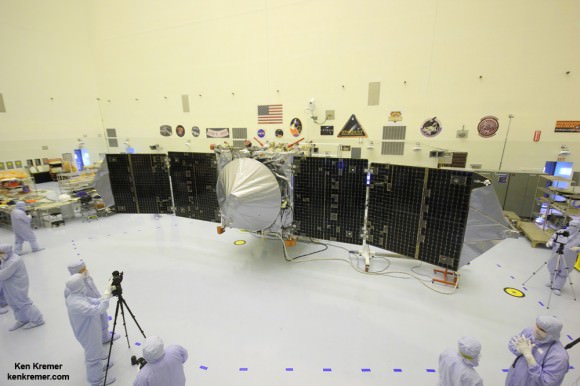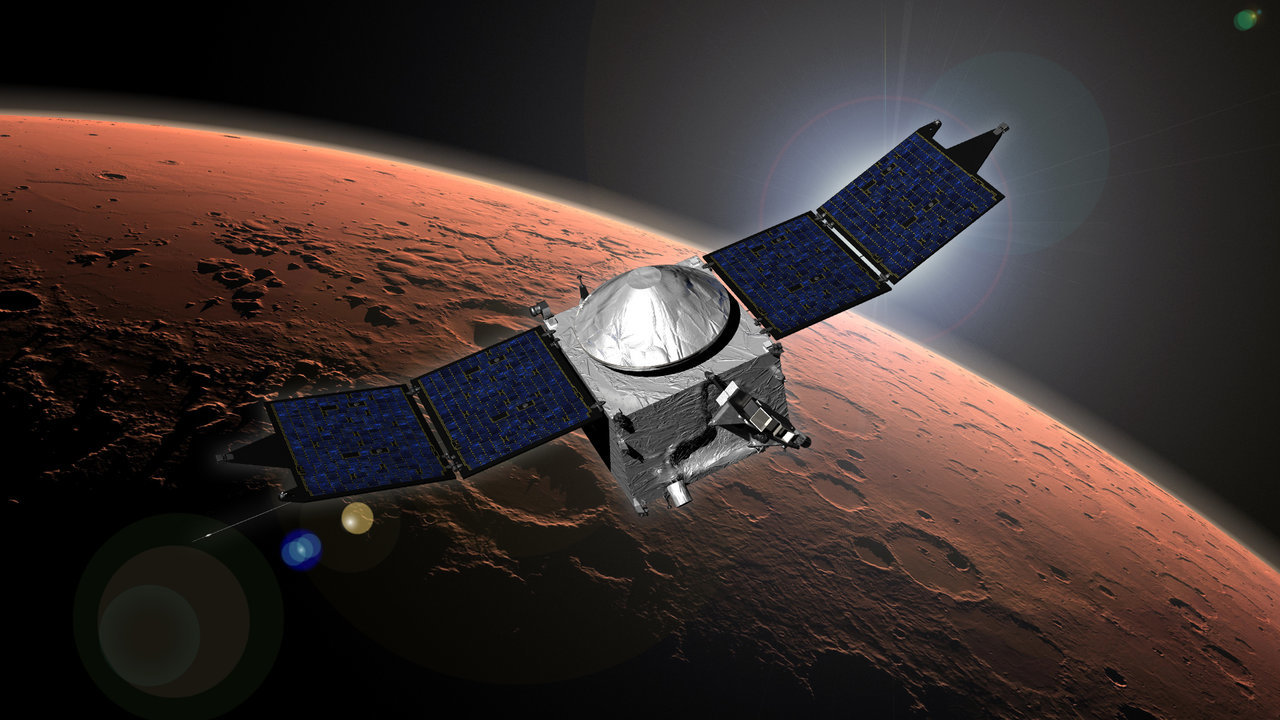After orbiting Mars for eight long years, NASA’s Mars Atmosphere and Volatile EvolutioN (MAVEN) spacecraft observed an extraordinary duo of auroras around the Red Planet that resulted from solar storms emanating from the Sun only a few days earlier on August 27. This observation is extraordinary since Mars lacks a global magnetic field so the solar flares must have been very powerful for MAVEN to detect them.
Continue reading “NASA’s MAVEN Witnessed Auroras as Multiple Solar Storms Crashed into Mars”Eight Missions are Getting Extensions, Most Exciting: OSIRIS-REx is Going to Asteroid Apophis

NASA has granted mission extensions to eight different planetary missions, citing the continued excellent operations of the spacecraft, but more importantly, the sustained scientific productivity of these missions, “and the potential to deepen our knowledge and understanding of the solar system and beyond.” Each mission will be extended for three more years.
One of the most exciting extensions gives a new mission to the OSIRIS-REx spacecraft, sending it to one of the most infamous asteroids of them all, the potentially hazardous asteroid Apophis.
Continue reading “Eight Missions are Getting Extensions, Most Exciting: OSIRIS-REx is Going to Asteroid Apophis”NASA Approves New Horizons Extended KBO Mission, Keeps Dawn at Ceres

In an ‘Independence Day’ gift to a slew of US planetary research scientists, NASA has granted approval to nine ongoing missions to continue for another two years this holiday weekend.
The biggest news is that NASA green lighted a mission extension for the New Horizons probe to fly deeper into the Kuiper Belt and decided to keep the Dawn probe at Ceres forever, rather than dispatching it to a record breaking third main belt asteroid.
And the exciting extension news comes just as the agency’s Juno probe is about to ignite a do or die July 4 fireworks display to achieve orbit at Jupiter – detailed here.
“Mission approved!” the researchers gleefully reported on the probes Facebook and Twitter social media pages.
“Our extended mission into the #KuiperBelt has been approved. Thanks to everyone for following along & hopefully the best is yet to come.

The New Horizons spacecraft will now continue on course in the Kuiper Belt towards an small object known as 2014 MU69, to carry out the most distant close encounter with a celestial object in human history.
“Here’s to continued success!”
The spacecraft will rendezvous with the ancient rock on New Year’s Day 2019.
Researchers say that 2014 MU69 is considered as one of the early building blocks of the solar system and as such will be invaluable to scientists studying the origin of our solar system how it evolved.
It was almost exactly one year ago on July 14, 2015 that New Horizons conducted Earth’s first ever up close flyby and science reconnaissance of Pluto – the most distant planet in our solar system and the last of the nine planets to be explored.
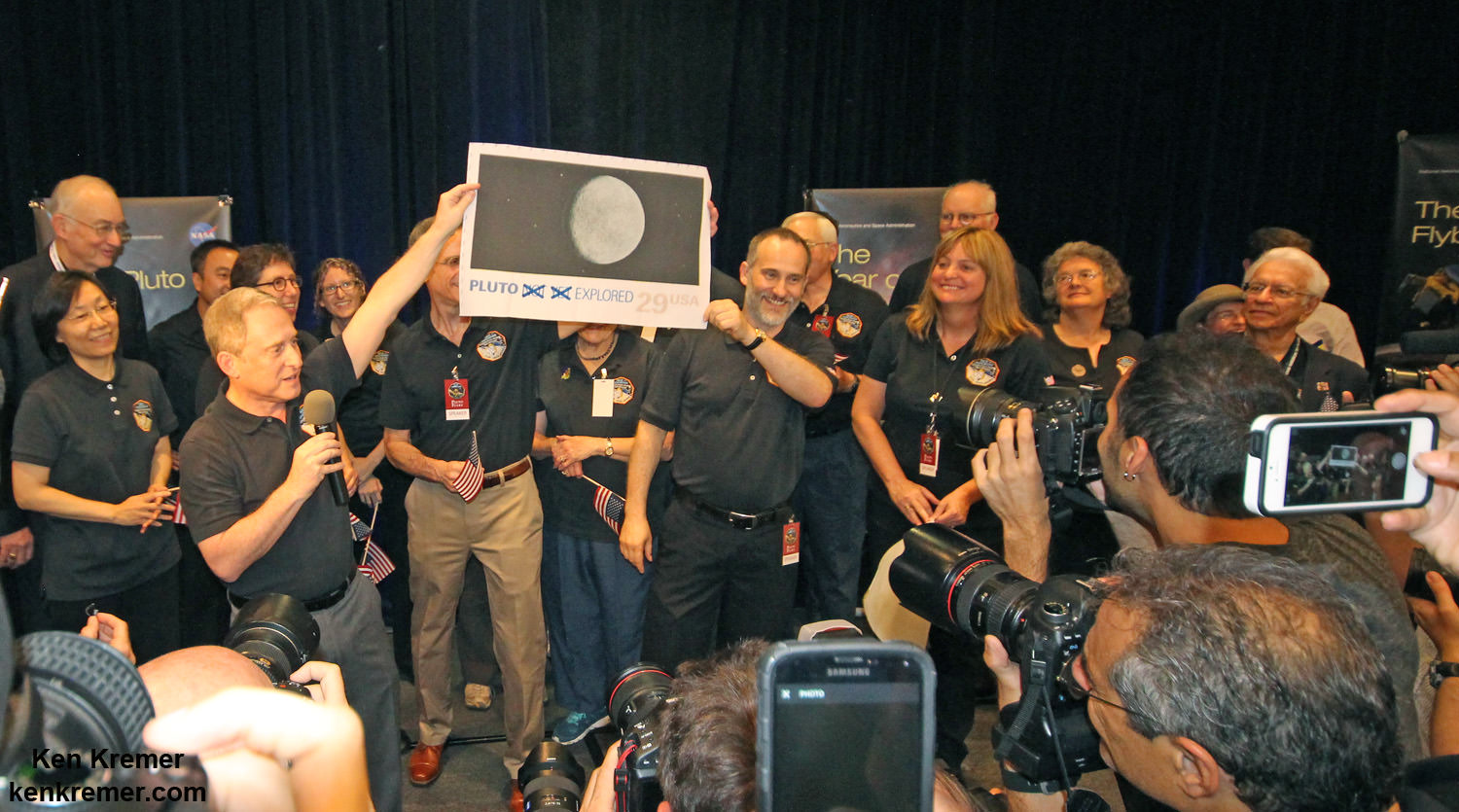
The immense volume of data gathered continues to stream back to Earth every day.
“The New Horizons mission to Pluto exceeded our expectations and even today the data from the spacecraft continue to surprise,” said NASA’s Director of Planetary Science Jim Green at NASA HQ in Washington, D.C.
“We’re excited to continue onward into the dark depths of the outer solar system to a science target that wasn’t even discovered when the spacecraft launched.”
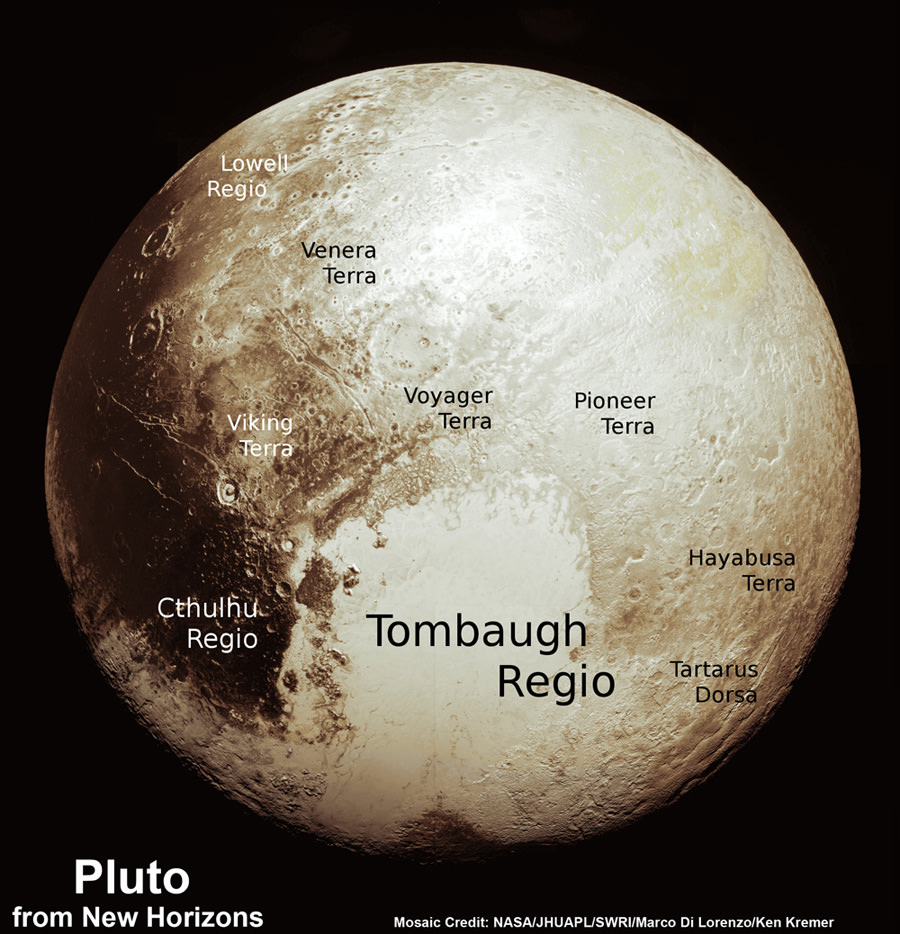
While waiting for news on whether NASA would approve an extended mission, the New Horizons engineering and science team already ignited the main engine four times to carry out four course changes in October and November 2015, in order to preserve the option of the flyby past 2014 MU69 on Jan 1, 2019.
Green noted that mission extensions into fiscal years 2017 and 2018 are not final until Congress actually passes sufficient appropriation to fund NASA’s Planetary Science Division.
“Final decisions on mission extensions are contingent on the outcome of the annual budget process.”
Tough choices were made even tougher because the Obama Administration has cut funding for the Planetary Sciences Division – some of which was restored by a bipartisan majority in Congress for what many consider NASA’s ‘crown jewels.’
NASA’s Dawn asteroid orbiter just completed its primary mission at dwarf planet Ceres on June 30, just in time for the global celebration known as Asteroid Day.
“The mission exceeded all expectations originally set for its exploration of protoplanet Vesta and dwarf planet Ceres,” said NASA officials.
The Dawn science team had recently submitted a proposal to break out of orbit around the middle of this month in order to this conduct a flyby of the main belt asteroid Adeona.
Green declined to approve the Dawn proposal, citing additional valuable science to be gathered at Ceres.
The long-term monitoring of Ceres, particularly as it gets closer to perihelion – the part of its orbit with the shortest distance to the sun — has the potential to provide more significant science discoveries than a flyby of Adeona,” he said.
The funding required for a multi-year mission to Adeona would be difficult in these cost constrained times.
However the spacecraft is in excellent shape and the trio of science instruments are in excellent health.
Dawn arrived at Ceres on March 6, 2015 and has been conducting unprecedented investigation ever since.
Dawn is Earth’s first probe in human history to explore any dwarf planet, the first to explore Ceres up close and the first to orbit two celestial bodies.
The asteroid Vesta was Dawn’s first orbital target where it conducted extensive observations of the bizarre world for over a year in 2011 and 2012.
The mission is expected to last until at least later into 2016, and possibly longer, depending upon fuel reserves.
Due to expert engineering and handling by the Dawn mission team, the probe unexpectedly has hydrazine maneuvering fuel leftover.
Dawn will remain at its current altitude at the Low Altitude Mapping Orbit (LAMO) for the rest of its mission, and indefinitely afterward, even when no further communications are possible.
Green based his decision on the mission extensions on the biannual peer review scientific assessment by the Senior Review Panel.
Dawn was launched in September 2007.
The other mission extensions – contingent on available resources – are: the Mars Reconnaissance Orbiter (MRO), Mars Atmosphere and Volatile EvolutioN (MAVEN), the Opportunity and Curiosity Mars rovers, the Mars Odyssey orbiter, the Lunar Reconnaissance Orbiter (LRO), and NASA’s support for the European Space Agency’s Mars Express mission.
Stay tuned here for Ken’s continuing Earth and planetary science and human spaceflight news.
NASA’s MAVEN Orbiter Discovers Solar Wind Stripped Away Mars Atmosphere Causing Radical Transformation

NASA’s Mars Atmosphere and Volatile Evolution (MAVEN) orbiter mission has determined that ancient Mars suffered drastic climate change and lost its thick atmosphere and surface bodies of potentially life giving liquid water because it lost tremendous quantities of gas to space via stripping by the solar wind, based on new findings that were announced today, Nov. 5, at a NASA media briefing and in a series of scientific publications.
The process of Mars dramatic transformation from a more Earth-like world to its barren state today started about 4.2 Billion years ago as the shielding effect of the global magnetic field was lost as the planets internal dynamo cooled, Bruce Jakosky, MAVEN principal investigator at the Laboratory for Atmospheric and Space Physics (LASP) at the University of Colorado, Boulder, told Universe Today.
The radical transformation of ancient Mars from a warm world with significant bodies of standing water that could have supported life, to its current state as a cold, arid and desert-like world that’s rather inhospitable to life was caused by the loss of most the planet’s atmosphere as powerful streams of solar wind particles crashed into it and stripped it away due to the loss of the protective magnetic field as the planets core cooled.
“We think that the early magnetic field that Mars had would have protected the planet from direct impact by the solar wind and would have kept it from stripping gas off,” Jakosky told me.
“So it would have been the turn off of the magnetic field, that would have allowed the turn on of stripping of the atmosphere by the solar wind.”
“The evidence suggests that the magnetic field disappeared about 4.2 Billion years ago.”
The period of abundant surface water actively carving the Martian geology lasted until about 3.7 Billion years ago. The loss of the atmosphere by stripping of the solar wind took place from about 4.2 to 3.7 Billion years ago.
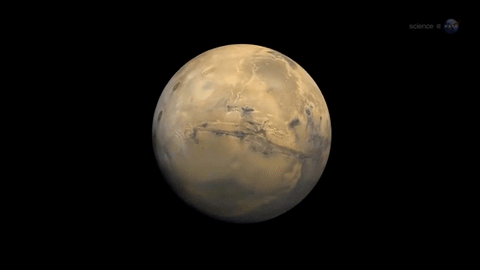
With the release of today’s results, the MAVEN science team has accomplished the primary goal of the mission, which was to determine how and why Mars lost its early, thick atmosphere and water over the past four billion years. The atmosphere is composed mostly of carbon dioxide.
Since water is a prerequisite for life as we know it, determining its fate and longevity on Mars is crucial for determining the habitability of the Red Planet and its potential for supporting martian microbes, past of present if they ever existed.
“The NASA Mars exploration program has been focused on finding water,” said Michael Meyer, lead scientist for the Mars Exploration Program at NASA Headquarters.
“Water is the prime ingredient needed for life. It is a major factor in the climate and for shaping geology. And it is a critical resource for future human exploration.”
NASA’s goal is to send humans on a ‘Journey to Mars’ during the 2030s.
This NASA video shows a visualization of the solar wind striking Mars:
Video caption: Created using data from NASA’s Mars Atmosphere and Volatile Evolution (MAVEN) mission, this visualization shows how the solar wind strips ions from the Mars’ upper atmosphere into space. Credits: NASA-GSFC/CU Boulder LASP/University of Iowa
MAVEN arrived in orbit at Mars just over one year ago on Sept. 21, 2014.
The $671 Million MAVEN spacecraft’s goal is to study Mars tenuous upper atmosphere in detail for the very first time by any spacecraft and to explore the mechanisms of how the planet lost its atmosphere and life giving water over billions of years as well as determine the rate of atmospheric loss.
The new MAVEN data have enabled researchers to measure the rate of Mars atmospheric loss of gas to space via the action of solar wind stripping as well as the erosional effect of solar storms.
Based on measurements from MAVEN’s suite of nine state-of-the-art scientific instruments, the solar wind is stripping away gas at a rate of about 100 grams (equivalent to roughly 1/4 pound) every second today, in the form of carbon dioxide and oxygen, said David Brain, MAVEN co-investigator at LASP.
“Most of the stripping [of the Martian atmosphere] by the solar wind at Mars was thought to have taken place very early in the history of the solar system when the sun was much more active and when the solar wind was more intense. So today the rate of loss at Mars is low,” Jakosky said at the briefing.
“Today’s Mars is a cold dry desert-like environment. The atmosphere is thin and it’s not capable of sustaining liquid water at the surface today, it would freeze or evaporate very quickly. However when we look at ancient Mars we see a different type of surface, one that had valleys that looked like they were carved by water and lakes that were standing for long periods of time. We see an environment that was much more able to support liquid water.”
The MAVEN results were published today in nearly four dozen scientific papers in the Nov. 5 issues of the journals Science and Geophysical Research Letters.
I asked Jakosky; How much gas would have been lost from ancient Mars and what is the rough estimate for the ancient rate of loss to arrive at Mars thin atmosphere today?
“For the amount of gas that we think you would have to have been removed – let me start with the current Mars atmosphere which has a thickness of 6 millibars, that’s just under 1% as thick as the Earth’s atmosphere,” Jakosky replied.
“So we think you would have to remove an amount of gas that is about equivalent to what’s in Earth’s atmosphere today.”
“So the rate would have to have been a factor of about 100 to 1000 times higher, than today’s loss of 100 grams per second in order to have removed the gas early in that time period, which is consistent with what the models have predicted that the loss rate would have been back then in early history.”
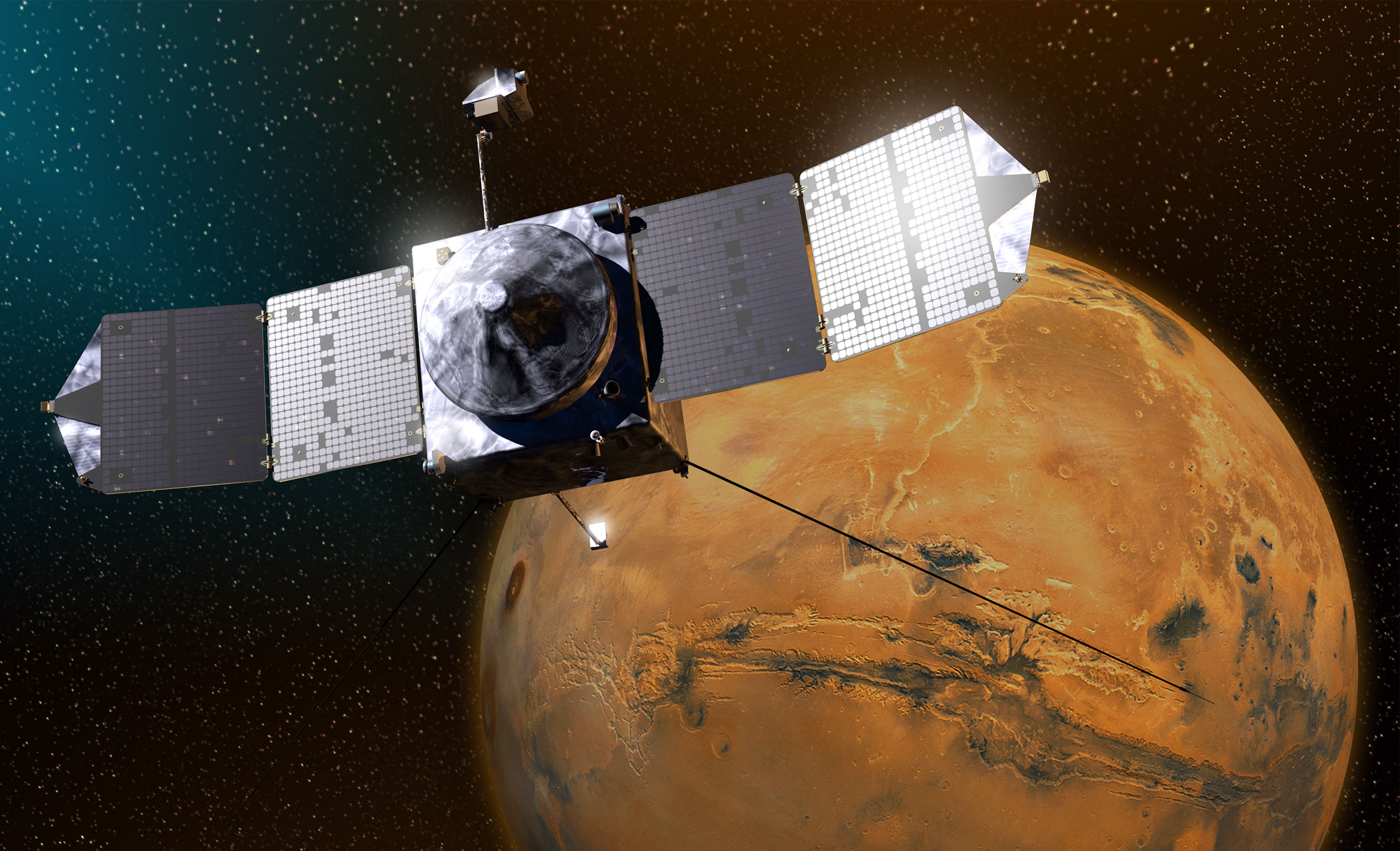
What is the solar wind and how does it strip away the atmosphere?
“The solar wind is a stream of particles, mainly protons and electrons, flowing from the sun’s atmosphere at a speed of about one million miles per hour. The magnetic field carried by the solar wind as it flows past Mars can generate an electric field, much as a turbine on Earth can be used to generate electricity. This electric field accelerates electrically charged gas atoms, called ions, in Mars’ upper atmosphere and shoots them into space,” according to a NASA description.
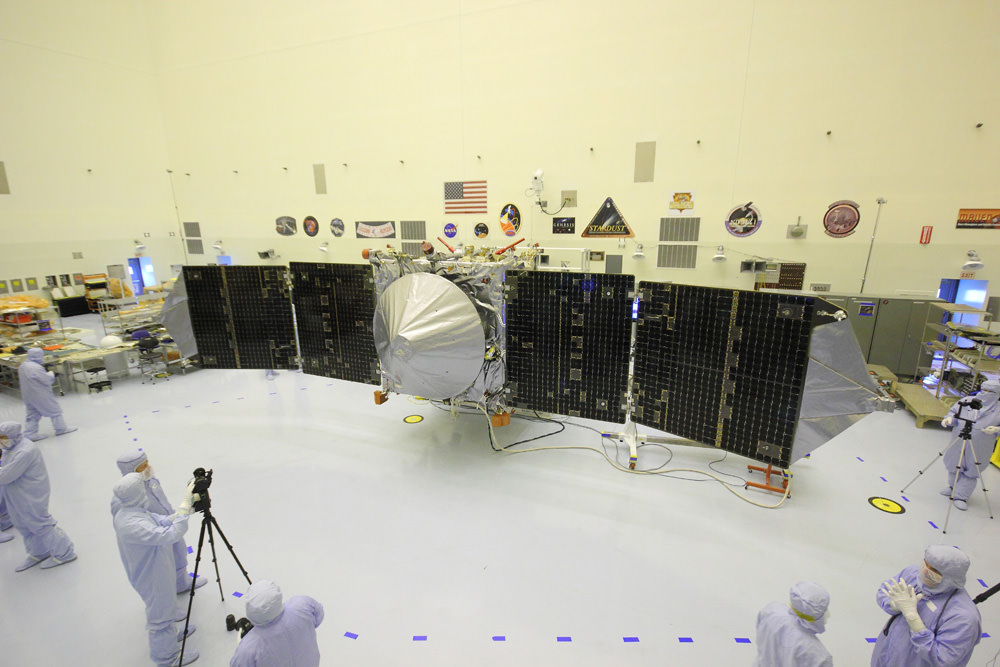
MAVEN is just now completing its primary mission and starts the extended mission phase on Nov. 16.
The 5,400 pound MAVEN probe carries nine sensors in three instrument suites to study why and exactly when did Mars undergo the radical climatic transformation.
MAVEN’s observations will be tied in with NASA’s ongoing Curiosity and Opportunity surface roving missions as well as MRO and Mars Odyssey to provide the most complete picture of the fourth rock from the sun that humanity has ever had.
MAVEN thundered to space on Nov. 18, 2013 following a flawless blastoff from Cape Canaveral Air Force Station’s Space Launch Complex 41 atop a powerful United Launch Alliance Atlas V rocket.
Stay tuned here for Ken’s continuing Earth and planetary science and human spaceflight news.
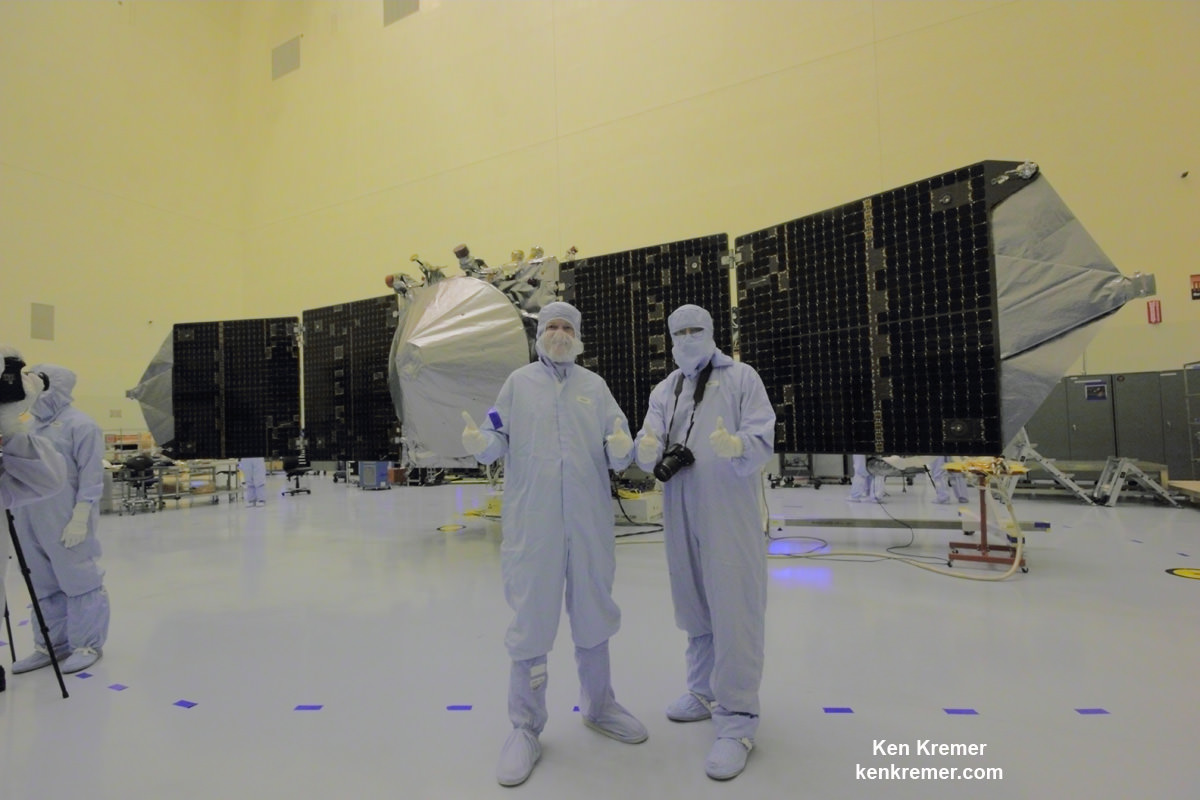
India’s Historic 1st Mission to Mars Celebrates 1 Year in Orbit at Red Planet

MOM celebrates 1 Year at Mars
Olympus Mons, Tharsis Bulge trio of volcanoes and Valles Marineris from ISRO’s Mars Orbiter Mission. Note the clouds and south polar ice cap. Credit: ISRO[/caption]
India’s historic first mission to Mars is now celebrating one year orbiting the Red Planet and may continue working for years to come. During year one the spacecraft was highly productive, achieving its goals of taking hordes of breathtaking images and gathering scientific measurements to study Mars atmosphere, surface environments, morphology, and mineralogy.
The Mars Orbiter Mission, or MOM, is India’s first deep space voyager to explore beyond the confines of her home planets influence and successfully arrived at the Red Planet after the “history creating” orbital insertion maneuver on Sept. 23/24, 2014 following a ten month interplanetary journey from Earth.
The MOM orbiter was designed and developed by the Indian Space Research Organization (ISRO), India’s space agency, which is the equivalent of NASA.
“Mars Orbiter spacecraft marks one year of its life around the Red Planet today [Sept. 24, IST],” said ISRO. It was primarily designed as a technology demonstrator but is also outfitted with significant science instruments.

The probe is equipped with a 15 kg (33 lb) suite of five indigenous instruments to conduct meaningful science – including the tri color Mars Color Camera imager (MCC) and a methane gas sniffer (MSM) to study the Red Planet’s atmosphere, morphology, mineralogy and surface features. Methane on Earth originates from both geological and biological sources – and could be a potential marker for the existence of Martian microbes.
“After successfully completing one year of the mission life around Mars, now a large data set has been acquired by all five payloads of MOM,” ISRO stated.
To mark the one year anniversary ISRO released a new 120 page “Mars Atlas” of imagery and results, which can be downloaded from the ISRO website.
“The images from MCC have provided unique information about Mars at varying spatial resolutions. It has obtained Mars Global data showing clouds, dust in atmosphere and surface albedo variations, when acquired from apoapsis at around 72000 km.”
“On the other hand high resolution images acquired from periapsis show details of various morphological features on the surface of Mars. Some of these images have been showcased in this atlas. The images have been categorized depending upon the Martian surface and atmospheric processes.”

MOM was built in record time and for a budget of $73 million.
“The MOM spacecraft was designed, built and launched in record period of less than two years,” ISRO explained. “MOM carried five science instruments collecting data on surface geology, morphology, atmospheric processes, surface temperature and atmospheric escape process.”
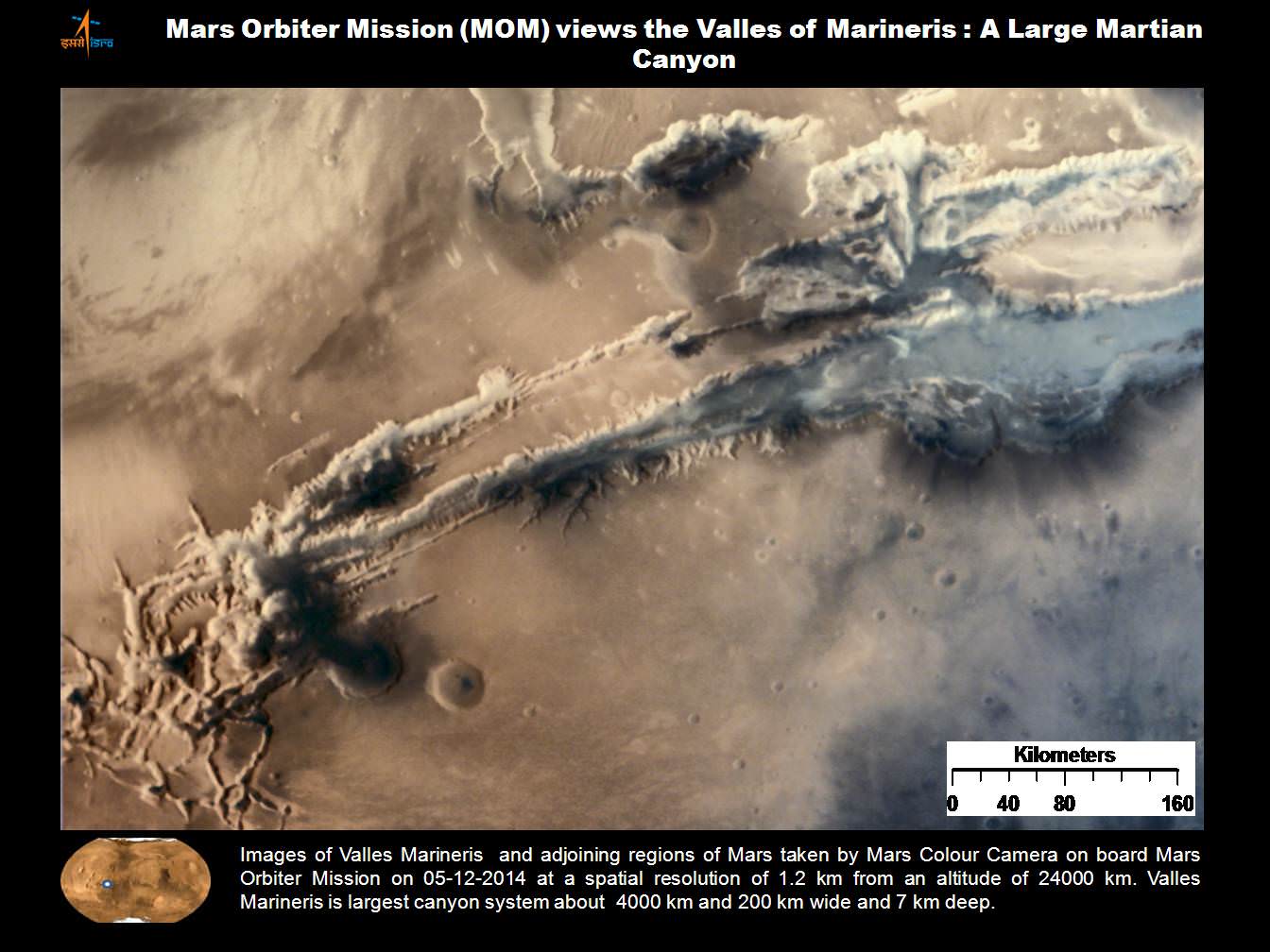
MOM’s Martian arrival was webcast worldwide with an elaborate ceremony that included India’s prime minister who beamed with pride in the team and the nation at that time.
“India has successfully reached Mars!” declared Indian prime minister Narendra Modi, who watched the events unfold from mission control at ISRO’s Telemetry, Tracking and Command Network (ISTRAC) in Bangalore, on Sept. 24, 2014.
“History has been created today. We have dared to reach out into the unknown and have achieved the near-impossible. I congratulate all ISRO scientists as well as all my fellow Indians on this historic occasion.”
MOM swoops around the Red Planet in a highly elliptical orbit whose nearest point to Mars (periapsis) is about 421.7 km and farthest point (apoapsis) is about 76,993.6 km, according to ISRO
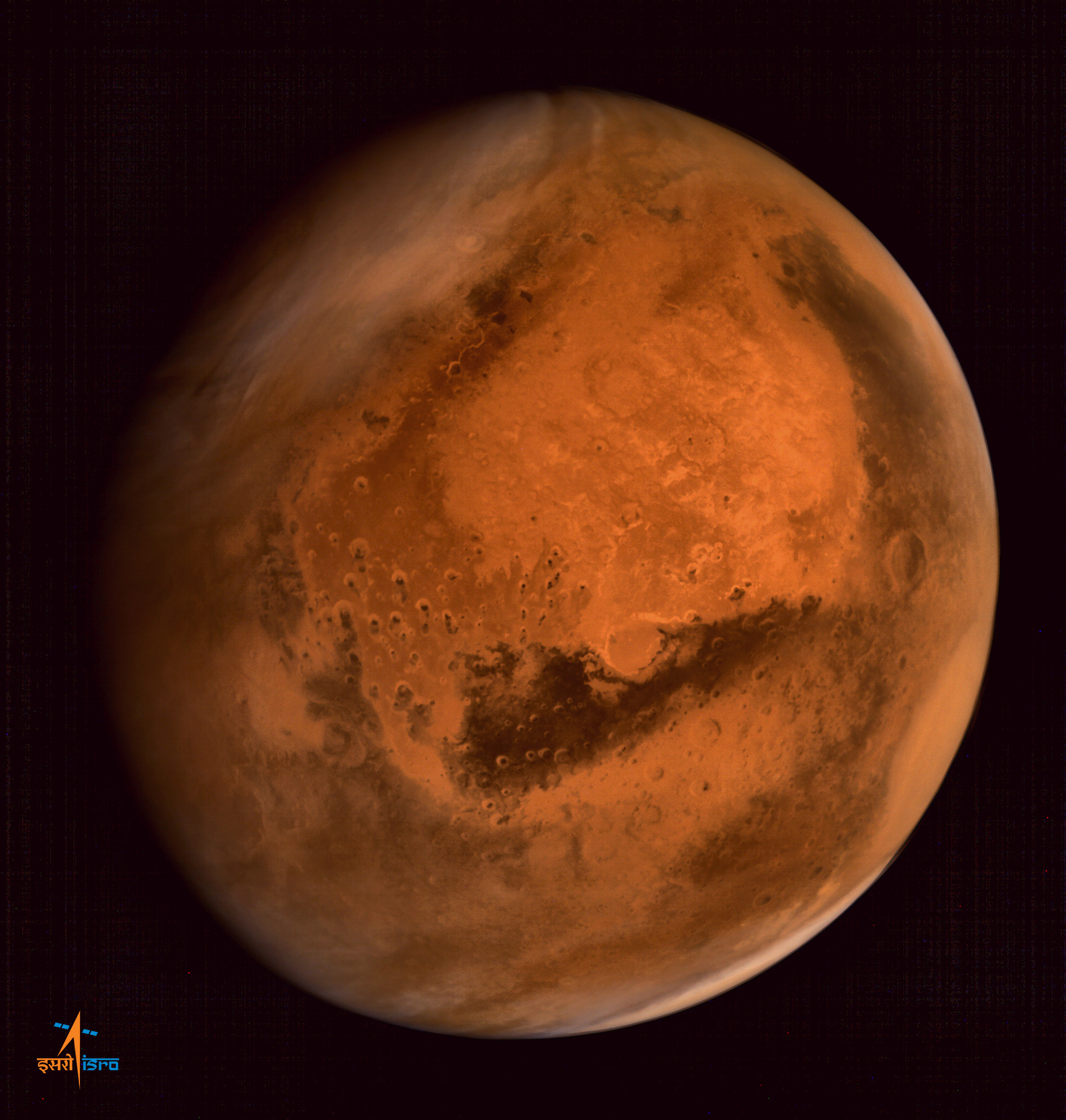
Upon MOM’s arrival, India became the newest member of an elite club of only four entities who have launched probes that successfully investigated Mars – following the Soviet Union, the United States and the European Space Agency (ESA).
MOM was launched on Nov. 5, 2013 from India’s spaceport at the Satish Dhawan Space Centre, Sriharikota, atop the nations indigenous four stage Polar Satellite Launch Vehicle (PSLV) which placed the probe into its initial Earth parking orbit.

The Indian probe arrived just two days after NASA’s MAVEN Mars orbiter, the first mission specifically targeted to study Mars tenuous upper atmosphere and the escape rates of atmospheric constituents.
The $73 million MOM mission was initially expected to last at least six months. In March 2015, ISRO extended the mission duration for another six months since its healthy, the five science instruments were operating fine and it had sufficient fuel reserves.
Indeed MOM has enough fuel to continue gather data and images for years to come if the instruments and spacecraft continue to function nominally.
“The Mars Orbiter Mission still has some 45 kg of fuel left which could, in theory, keep the mission going for at least 15 years,” ISRO told The Hindu.
“One cannot get a better bang for the buck! According to ISRO, for normal housekeeping operations and orbit maintenance only about two kg of fuel is necessary per year.”
Including MOM, Earth’s invasion fleet at the Red Planet numbers a total of seven spacecraft comprising five orbiters from NASA, ESA and ISRO as well as the sister pair of mobile surface rovers from NASA – Curiosity and Opportunity.
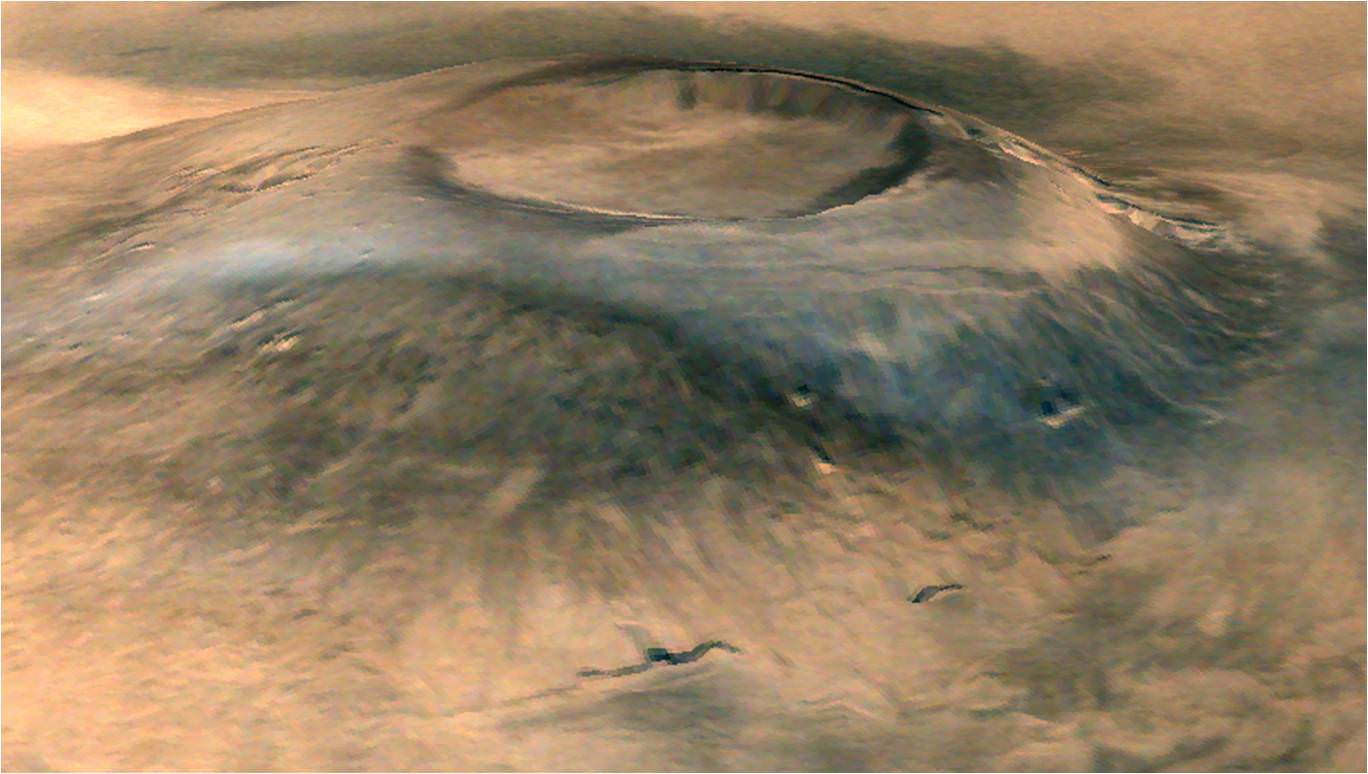
Stay tuned here for Ken’s continuing Earth and planetary science and human spaceflight news.

Best Space Photos Of 2014 Bring You Across The Solar System
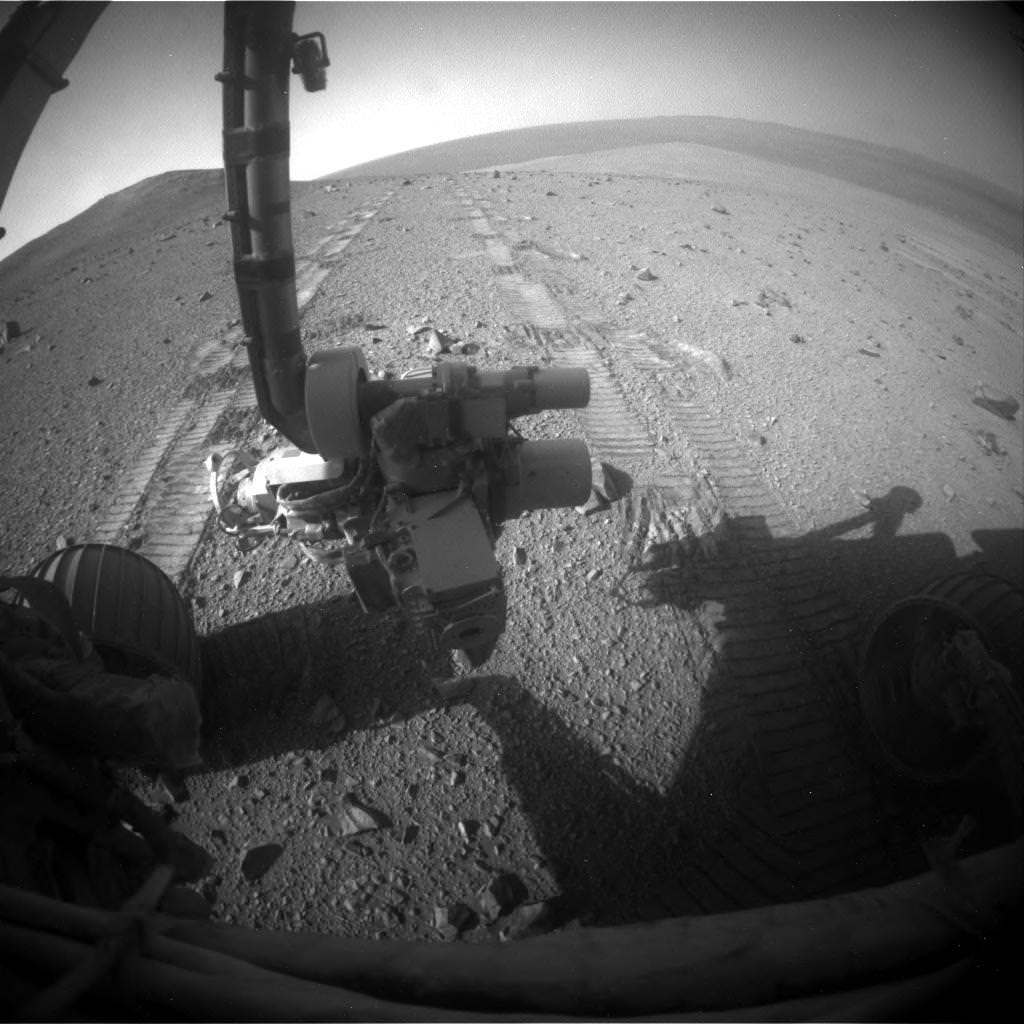
Feel like visiting a dwarf planet today? How about a comet or the planet Mars? Luckily for us, there are sentinels across the Solar System bringing us incredible images, allowing us to browse the photos and follow in the footsteps of these machines. And yes, there are even a few lucky humans taking pictures above Earth as well.
Below — not necessarily in any order — are some of the best space photos of 2014. You’ll catch glimpses of Pluto and Ceres (big destinations of 2015) and of course Comet 67P/Churyumov–Gerasimenko (for a mission that began close-up operations in 2014 and will continue next year.) Enjoy!
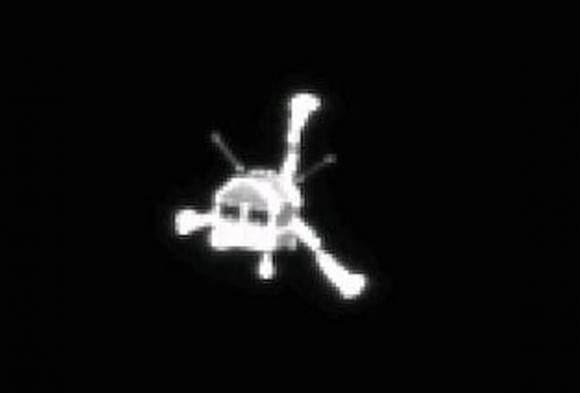
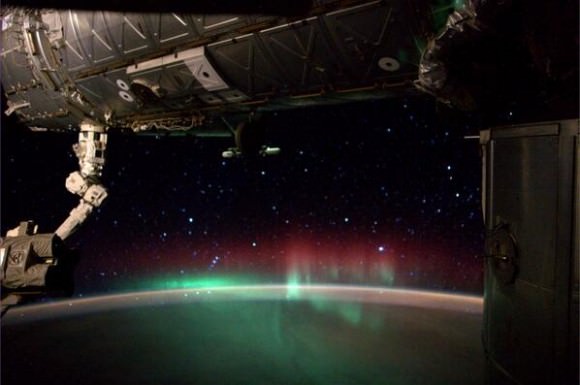
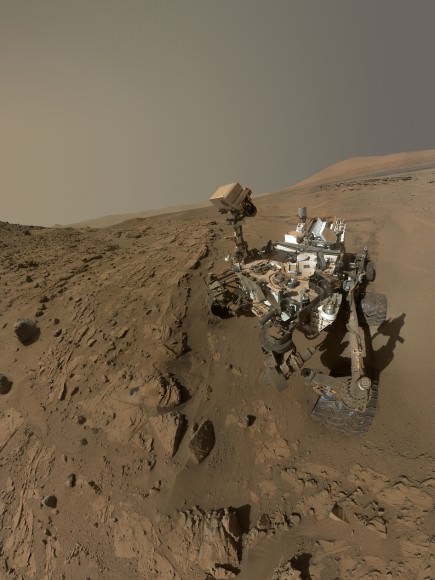
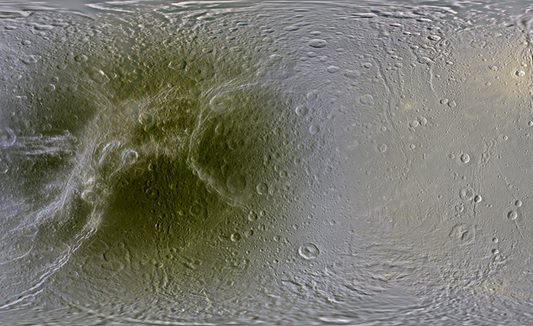

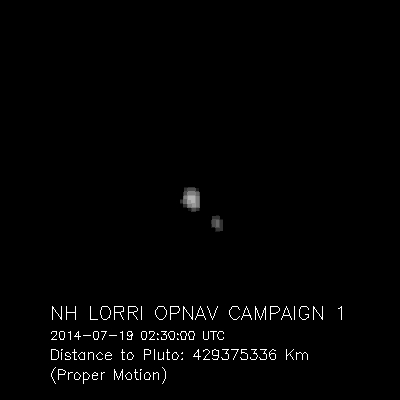
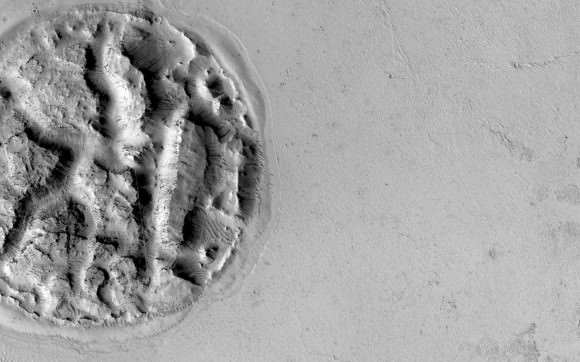
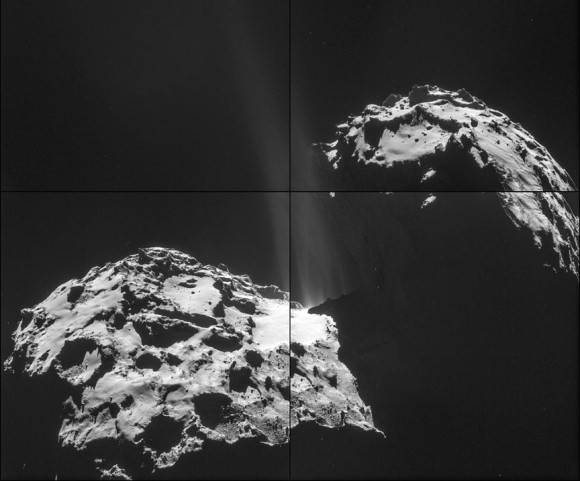

Orbital Sciences Selects ULA’s Atlas V to Launch Next Cygnus Cargo Ship to Station
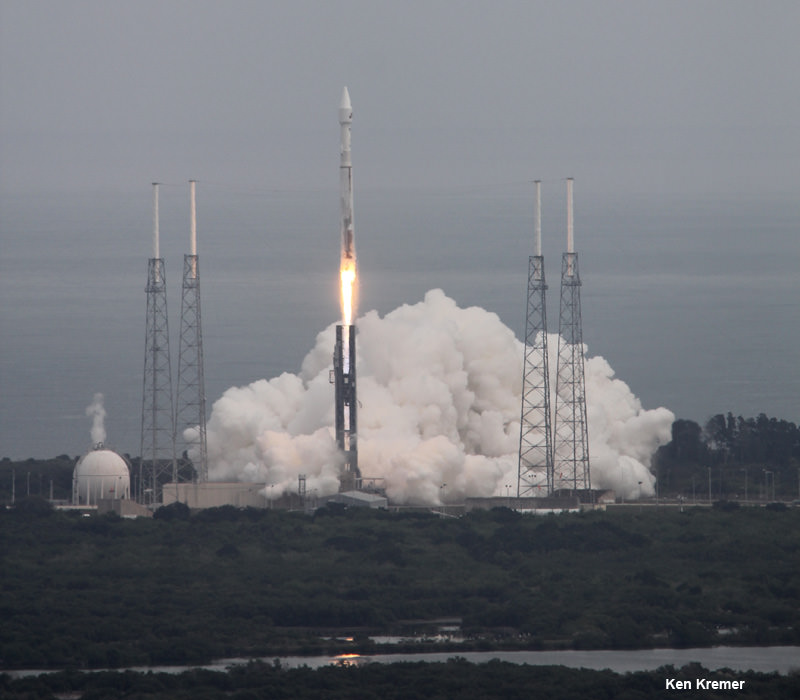
A United Launch Alliance Altas V 401 rocket like that shown here will launch the next Orbital Sciences Cygnus cargo ship to the space station in place of the Antares rocket. NASA’s Mars-bound MAVEN spacecraft launches atop Atlas V booster at 1:28 p.m. EST from Space Launch Complex 41 at Cape Canaveral Air Force Station on Nov. 18, 2013. Image taken from the roof of the Vehicle Assembly Building (VAB) at NASA’s Kennedy Space Center. Credit: Ken Kremer/kenkremer.com
More photos added[/caption]
Following the catastrophic Oct. 28 failure of an Orbital Sciences Corporation Antares rocket on a critical resupply mission to the space station for NASA, the company is seeking to quickly make up the loss to NASA by announcing the selection of the venerable Atlas V rocket built by United Launch Alliance to launch Orbital’s next Cygnus cargo ship to the orbital science lab.
Orbital and ULA signed a contract to launch at least one, and up to two, Cygnus cargo missions to the International Space Station (ISS) under NASA’s Commercial Resupply Services (CRS) program.
The first Cygnus mission would liftoff sometime late in the fourth quarter of 2015 aboard an Atlas V 401 vehicle from Space Launch Complex 41 (SLC-41) at Cape Canaveral Air Force Station in Florida.
Given that ULA’s full launch manifest was fairly full for the next 18 months, Orbital is fortunate to have arranged one or two available launch slots so quickly in the wake of the Antares launch disaster.
“Orbital is pleased to partner with ULA for these important cargo missions to the International Space Station,” said Frank Culbertson, Orbital executive vice president and general manager of its Advanced Programs Group.
“ULA’s ability to integrate and launch missions on relatively short notice demonstrates ULA’s manifest flexibility and responsiveness to customer launch needs.”

Orbital also stated that there will be “no cost increase to the space agency” by utilizing the Atlas V as an interim launcher.
If necessary, a second Cygnus would be launched by the Atlas V in 2016.
The 401 version of the Atlas uses a 4 meter diameter payload fairing, no solid rocket boosters strapped on to the first stage, and a single-engine Centaur upper stage.

Orbital had been evaluating at least three different potential launch providers.
Observers speculated that in addition to ULA, the other possibilities included a SpaceX Falcon 9 or a rocket from the European Space Agency at the Guiana Space Center.
“We could not be more honored that Orbital selected ULA to launch its Cygnus spacecraft,” said Jim Sponnick, vice president, Atlas and Delta Programs.
“This mission was awarded in a highly competitive environment, and we look forward to continuing ULA’s long history of providing reliable, cost-effective launch services for customers.”
The Orbital-3, or Orb-3, mission that ended in disaster on Oct. 28 was to be the third of eight cargo resupply missions to the ISS through 2016 under the NASA Commercial Resupply Services (CRS) contract award valued at $1.9 Billion.
The highly anticipated launch of the Antares rocket on Oct 28 suddenly went awry when one of the Soviet-era first stage engines unexpectedly exploded and cascaded into a spectacular aerial fireball just above the launch pad at NASA’s Wallops Flight Facility on the Orb-3 mission to the ISS.
Read my earlier eyewitness accounts at Universe Today.

Orbital was awarded a $1.9 Billion contract with NASA under the CRS program to deliver 20,000 kilograms of research experiments, crew provisions, spare parts, and hardware for the eight ISS flights.
In choosing the Atlas V with a greater lift capacity compared to Antares, Orbital will also be able to significantly increase the cargo mass loaded inside the Cygnus by about 35%.
This may allow Orbital to meet its overall space station payload obligation to NASA in 7 total flights vs. the originally planned 8.
The venerable Atlas V rocket is one of the most reliable and well built rockets in the world.
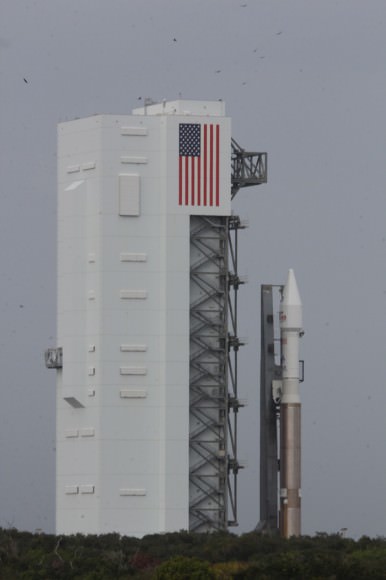
Indeed the Atlas V has been entrusted to launch many high value missions for NASA and the Defense Department – such as MAVEN, Curiosity, JUNO, TDRSS, and the X-37 B.
MAVEN launched on a similar 401 configuration being planned for Cygnus.
The two-stage Atlas rocket is also being man-rated right now to launch humans to low Earth orbit in the near future.
Orbital is still in the process of deciding on a new first stage propulsion system for Antares’ return to flight planned for perhaps sometime in 2016.
Watch here for Ken’s ongoing reporting about Antares and NASA Wallops.
Stay tuned here for Ken’s continuing Earth and Planetary science and human spaceflight news.
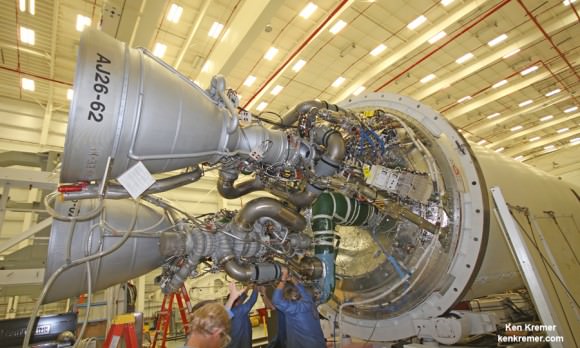
Comet Siding Spring Was Bleeding Hydrogen As It Sped By Mars

As Comet Siding Spring passed close by Mars on Sunday (Oct. 19), NASA’s newest Mars spacecraft took a time-out from its commissioning to grab some ultraviolet pictures of its coma. What you see above is hydrogen, a whole lot of it, leaving the comet in this picture taken from 5.3 million miles (8.5 million kilometers).
The hydrogen is a product of the water ice on the comet that the Sun is slowly melting and breaking apart into hydrogen and oxygen molecules. Because hydrogen scatters ultraviolet light from the Sun, it shows up rather clearly in this picture taken by the Mars Atmosphere and Volatile EvolutioN (MAVEN) spacecraft.
Check out more recent pictures of Siding Spring below.
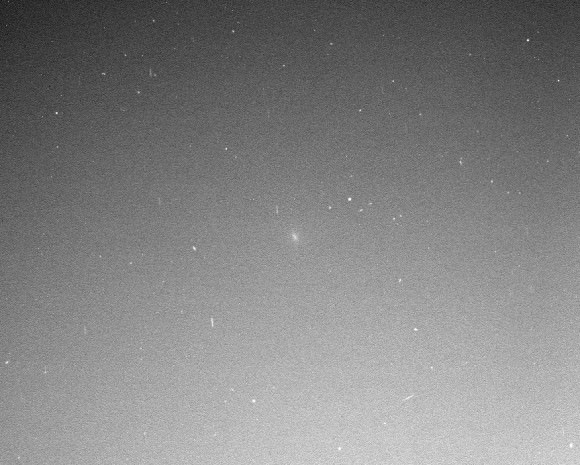
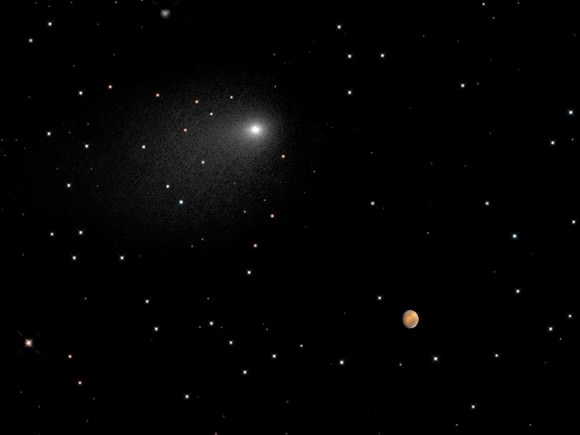
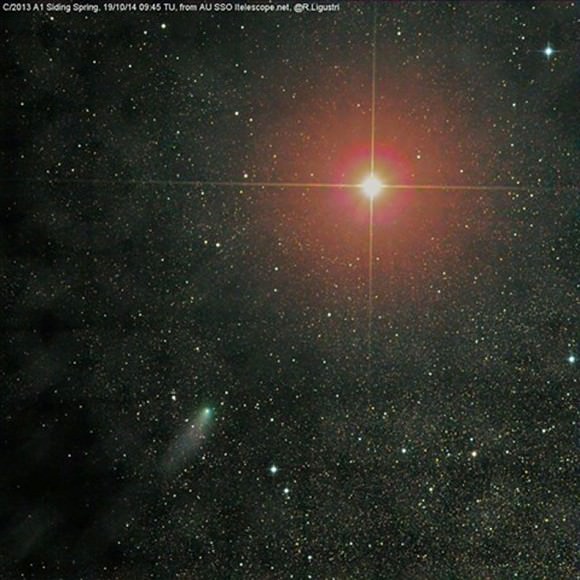
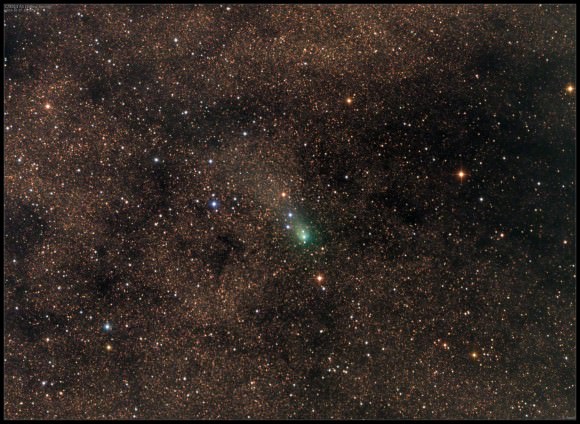
Stunning View of Solar System’s Largest Volcano and Valles Marineris Revealed by India’s Mars Orbiter Mission

India’s Mars Orbiter Mission (MOM) has delivered another sweet treat – a stunning view of our Solar System’s largest volcano and the largest canyon.
Just days ago, MOM captured a new global image of the Red Planet dominated by Olympus Mons and Valles Marineris – which is the largest known volcano and the largest known canyon in the Solar System, respectively.
Situated right in between lies a vast volcanic plateau holding a trio of huge volcanoes comprising the Tharsis Bulge: Arsia Mons, Pavonis Mons, and Ascraeus Mons. All four volcanoes are shield volcanoes.
To give an idea of its enormity, Olympus Mons stands about three times taller than Mount Everest and is about the size of Arizona.
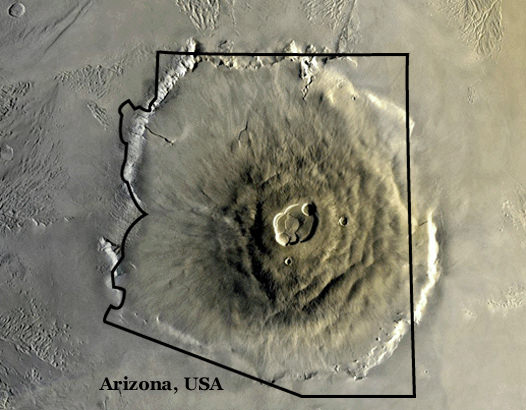
Olympus Mons is located in Mars’ western hemisphere and measures 624 kilometers (374 miles) in diameter, 25 km (16 mi) high, and is rimmed by a 6 km (4 mi) high scarp.
Valles Marineris is often called the “Grand Canyon of Mars.” It spans about as wide as the entire United States.
The Indian Space Research Organization (ISRO), India’s space agency which designed and developed the orbiter released the image on Oct. 17, barely two days ahead of the planet’s and spacecrafts’ extremely close encounter with comet Siding Spring.
By the way, a relieved ISRO tweeted MOM’s survival of her close shave with the once-in-a-lifetime cometary passage with gusto, soon after the swingby:
“Phew! Experience of a lifetime. Watched the #MarsComet #SidingSpring whizzing past the planet. I’m in my orbit, safe and sound.”
The new global image was taken by the tri-color camera as MOM swooped around the Red Planet in a highly elliptical orbit whose nearest point to Mars (periapsis) is at 421.7 km and farthest point (apoapsis) at 76,993.6 km, according to ISRO.
To date ISRO has released four global images of the Red Planet, including a 3-D view, reported here.
Olympus Mons, the Tharsis Bulge, and Valles Marineris are near the equator.
Valles Marineris stretches over 4,000 km (2,500 mi) across the Red Planet, is as much as 600 km wide, and measures as much as 7 kilometers (4 mi) deep.
Here’s a comparison view of the region taken by NASA’s Viking 1 orbiter in the 1970s.
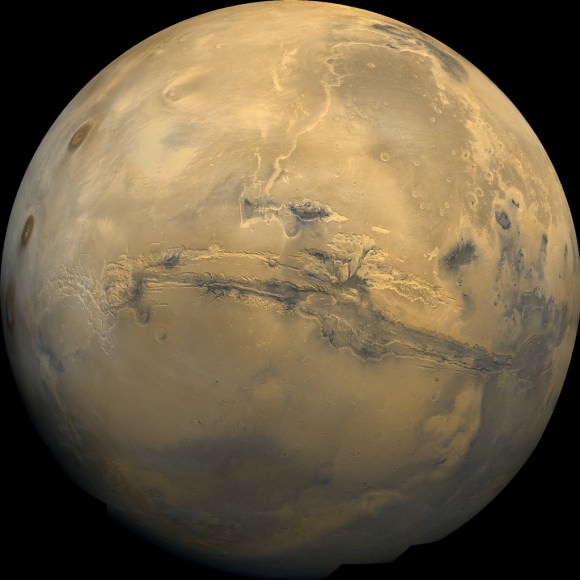
MOM is India’s first deep space voyager to explore beyond the confines of her home planet’s influence and successfully arrived at the Red Planet only one month ago after the “history creating” orbital insertion maneuver on Sept. 23/24 following a ten month journey.
The $73 million MOM mission is expected to last at least six months.
MOM’s success follows closely on the heels of NASA’s MAVEN orbiter which also successfully achieved orbit barely two days earlier on Sept. 21 and could last 10 years or more.
With MOM’s arrival, India became the newest member of an elite club of only four entities that have launched probes that successfully investigated Mars – following the Soviet Union, the United States, and the European Space Agency (ESA).
Stay tuned here for Ken’s continuing Earth and planetary science and human spaceflight news.
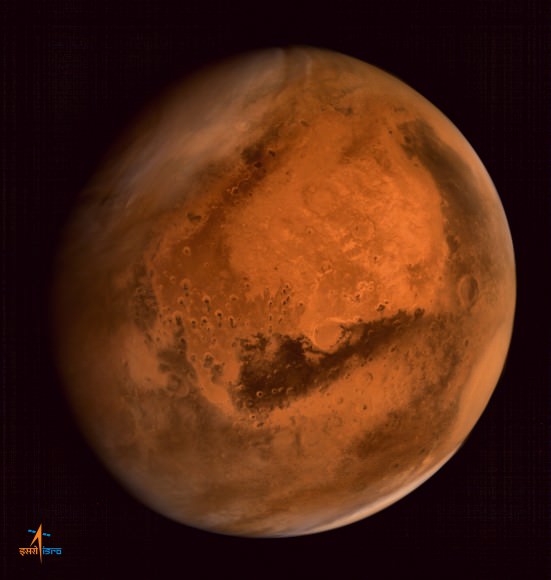
ISRO and NASA Ink Deal to Collaborate on Red Planet and Home Planet Science Missions
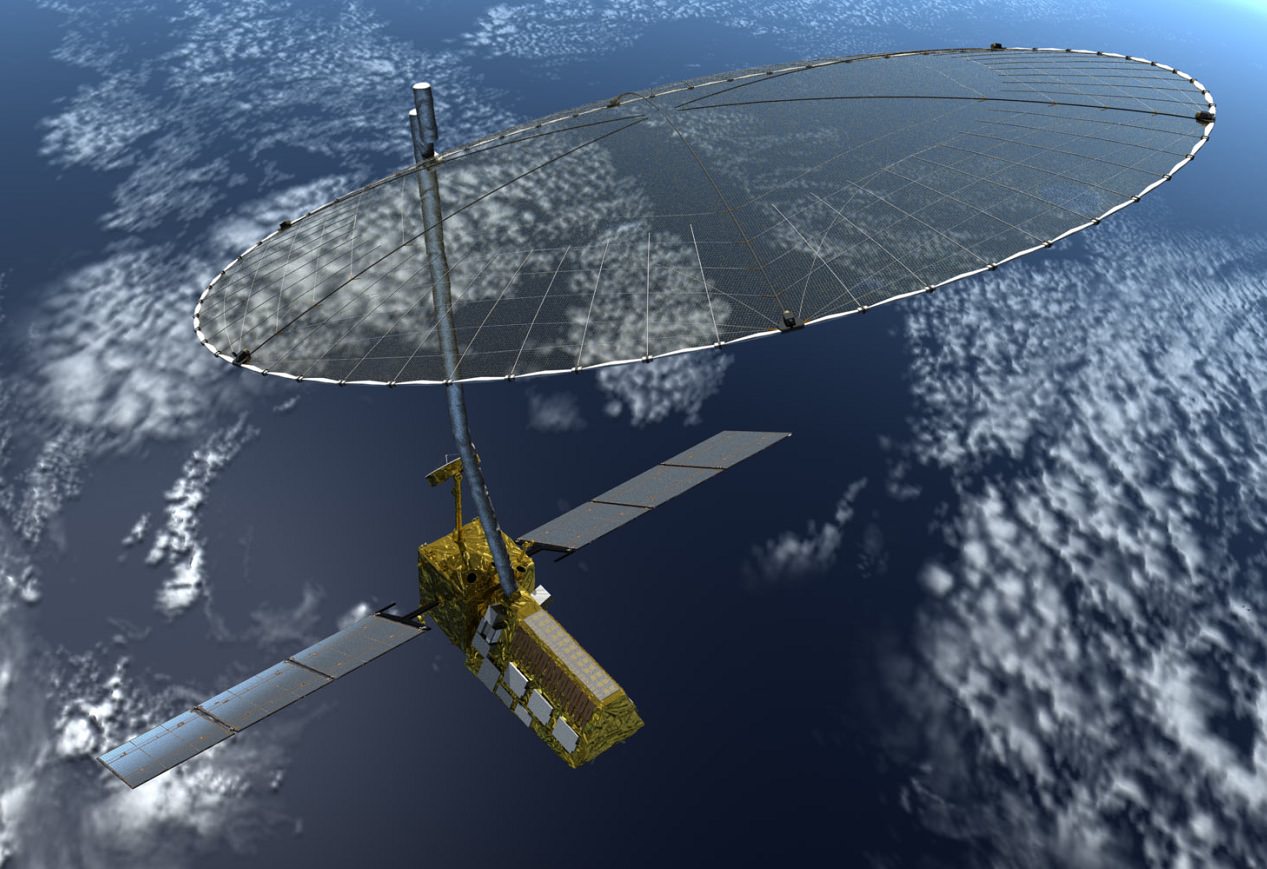
ISRO and NASA have inked a deal to collaborate on future missions to jointly explore the Red Planet and our Home Planet hot on the heels of ISRO’s wildly successful Mars Orbiter Mission (MOM), India’s first ever interplanetary voyager to explore Mars.
NASA Administrator Charles Bolden and K. Radhakrishnan, chairman of the Indian Space Research Organisation (ISRO), signed an agreement to collaborate on future science missions to explore Mars as well as to build and launch a joint NASA-ISRO mission to observe Earth.
The leaders of NASA and ISRO met in Toronto, Canada on Tuesday, Sept. 30 and “signed two documents to launch a NASA-ISRO satellite mission to observe Earth and establish a pathway for future joint missions to explore Mars,” according to a NASA statement.
Bolden and Rao met at the International Astronautical Congress underway in Toronto.
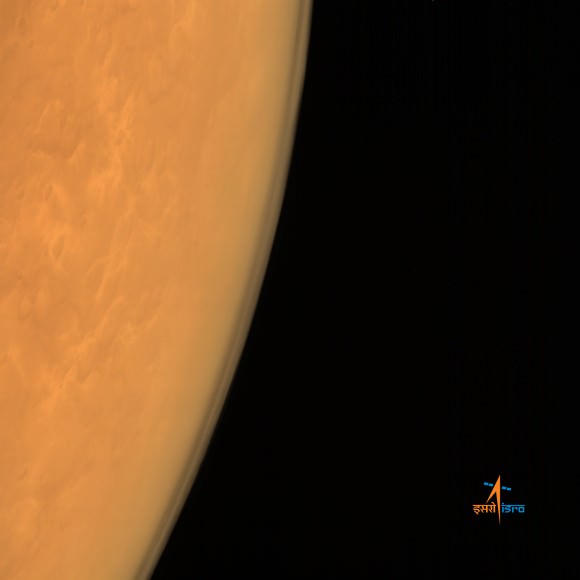
They signed one agreement defining each agency’s responsibilities for the joint NASA-ISRO Synthetic Aperture Radar (NISAR) mission, targeted to launch in 2020. NISAR will make global measurements of the causes and consequences of land surface changes.
The second agreement “establishes a NASA-ISRO Mars Working Group to investigate enhanced cooperation between the two countries in Mars exploration.”
“The signing of these two documents reflects the strong commitment NASA and ISRO have to advancing science and improving life on Earth,” said NASA Administrator Charles Bolden, in a NASA statement.
“This partnership will yield tangible benefits to both our countries and the world.”
NISAR will be the first Earth observing mission to be equipped two different synthetic aperture radar (SAR) frequencies (L-band and S-band) – one each from NASA and ISRO.
NASA will also provide “the high-rate communication subsystem for science data, GPS receivers, a solid state recorder, and a payload data subsystem.”
ISRO will provide the spacecraft bus and launch vehicle.
The radars will be able to measure subtle changes in Earth’s surface of less than a centimeter across stemming from the flow of glaciers and ice sheets as well as earthquakes and volcanoes.
Regarding Mars, the first subject the joint working group will tackle will be to coordinate observations from each nation’s recently arrived Mars orbiters – ISRO’s MOM and NASA’s MAVEN. They will also examine areas of future collaboration on surface rovers and orbiters.
“NASA and Indian scientists have a long history of collaboration in space science,” said John Grunsfeld, NASA Associate Administrator for Science.
“These new agreements between NASA and ISRO in Earth science and Mars exploration will significantly strengthen our ties and the science that we will be able to produce as a result.”
Stay tuned here for Ken’s continuing Earth and planetary science and human spaceflight news.
